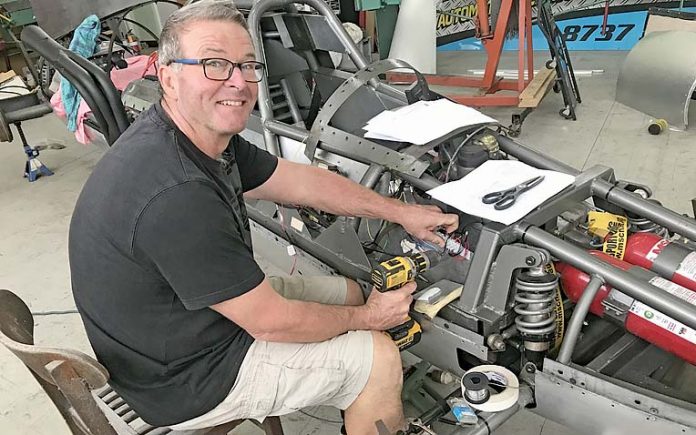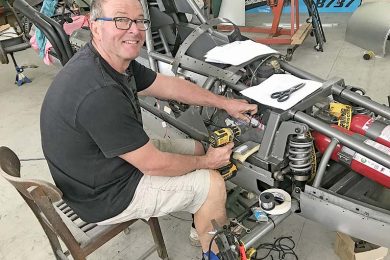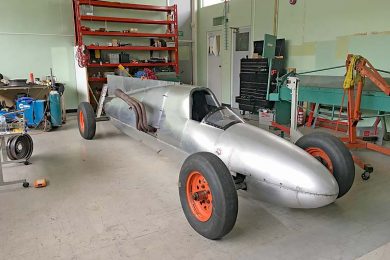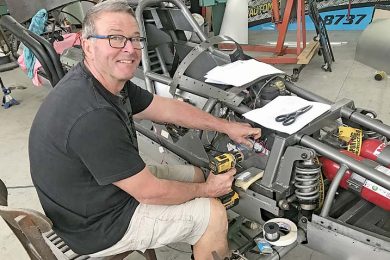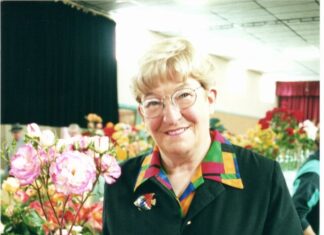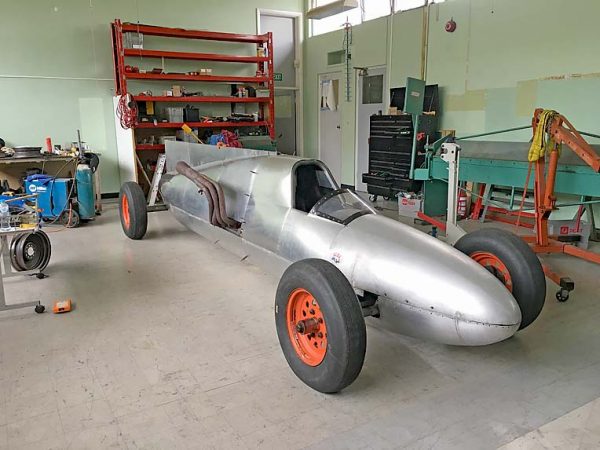
A YEAR of rebuilding has seen a pair of Penola land speed record holders improve their Lakester in readiness for another shot at the title.
David Bullock and Peter Taylor spent the “off-season” rebuilding their vehicle, dubbed the “Redneck Express”, with the main aim to break their current record of 389 kph – or 242 miles-per-hour, as the speeds are based on the United Sates values.
That was set at Lake Gairdner last year, with the hope to improve on that figure this year.
The Lakester is run under the Wombat Racing banner, a group with 30 years experience in motorsport, dating back to the days running HQ Holdens around the old Thunderdome at Calder Park.
The team was also set to unveil the “Redneck Express” NASCAR, built specifically for the task of going fast in a straight line by Noel Heenan in Mooroopna, Victoria.
“We were always planning to go up as a team,” Bullock said.
“The original Wombat Racing team, which is what we are, goes back to the early 90s with the HQs running around the Thunderdome.
“We have always been in touch and over the last six months myself and Noel talk on a weekly basis.
“The Wombat Racing team is still going strong and we were all pitted together.”
However, all plans have been put on hold due to the COVID-19 pandemic sweeping the globe.
Despite the setback Bullock seems as keen as ever to take the Lakester out as soon as possible to see if he can push it to new limits, with 260mph in his sights.
This year was also going to see Taylor push for his 200mph licence.
Plenty of work has gone into the project, with a lengthened chassis the major change, plus the fitting of a fin running along the back of the car to provide lateral stability.
“Myself and Peter Taylor have completely rebuilt the car twice now,” Bullock said.
“The first year we re-did all the suspension and this year we lengthened the car and did a fair bit of body work to it.
“We installed a radiator and have basically enclosed the whole car from the driver’s compartment all the way to the back.
“We also put a big fin on the back of it.
“It is about going faster and straighter.”
Bullock said the extra length would provide improved stability, as would the wing, which should give the drivers a bit more confidence as they push the limits on the salt-lake flats.
“The fin on the back of it is to try to keep it straight,” Bullock said.
“If it does step out a bit, the side forces on that will hopefully push it back straight.”
The biggest issue faced by the team is the sheer lack of testing.
There is simply nowhere they can run the vehicle – which only has around 5cm of clearance from the ground – at any speed, let alone the high speeds they reach on Lake Gairdner.
It is a matter of going out and testing as they go.
But that is nothing new to the pair.
“Over in America they are lucky because they have different events and there is an airforce base, or something like that, in Texas where they use a runway,” Bullock said.
“There is just nothing here in Australia to allow us to get up to those sorts of speeds.
“The first year we ran the car John Harding from Adelaide bought it and we went straight to Lake Gairdner.
“I did not even see the car until I got up there on the Sunday before the meeting.
“We had four drivers and they all pointed at me and said ‘you’re first’.
“I jumped in and my first run I did 113 miles-per-hour.
“I got out and said ‘boys, we have a lot of work to do’.
“We found a couple of things we could deal with up there which improved the car a lot and I did 212 miles-per-hour that first year.”
After years in the NASCAR game in America, Bullcok knew it was all about wind resistance and handling.
While he had played around with wind-tunnel testing in the USA, the cost was prohibitive here in Australia.
It was then a matter of using that experience to set the Lakester up and hope all went to plan when they hit the ground.
“We were still chasing a little bit of a handling issue after last year,” Bullock said.
“We have done some more work to the front end of the car to make sure the handling was right.
“It does not matter how slippery the car is or how much horsepower you have, if the handling is not there you are not going to go anywhere.
“We were confident with that and with the changes to the gearing and the aerodynamics we were looking for around 260 miles-per-hour.
“I have never worked on anything that has gone that fast.
“The most I have done was the NASCARs and they were a bit over 200 miles-per-hour.”
With speeds around those figures sure to be achieved and no real downforce – which would cause drag – there was the obvious problem of keeping the Lakester on the ground.
Bullock had a simple solution for that.
“Lots and lots of lead,” he said.
“I reckon we were a bit over 1100kg the first year and now we are just shy of 2000kg with the driver in the car.”
That much weight certainly needs horsepower to move it, which is in no short supply in the Lakester.
A company called Blueprint in America have built the engine, which Bullock said is based on Chevrolet components.
The 632 cubic inch big block engine produces around 800 horsepower running through a Doug Nash two-speed gear box.
At this stage it appears Bullock, Taylor and the Wombat Racing Team will probably have to wait until next year to run the salt flats of Lake Gairdner and he summed it up by simply saying “we will see what happens”.

